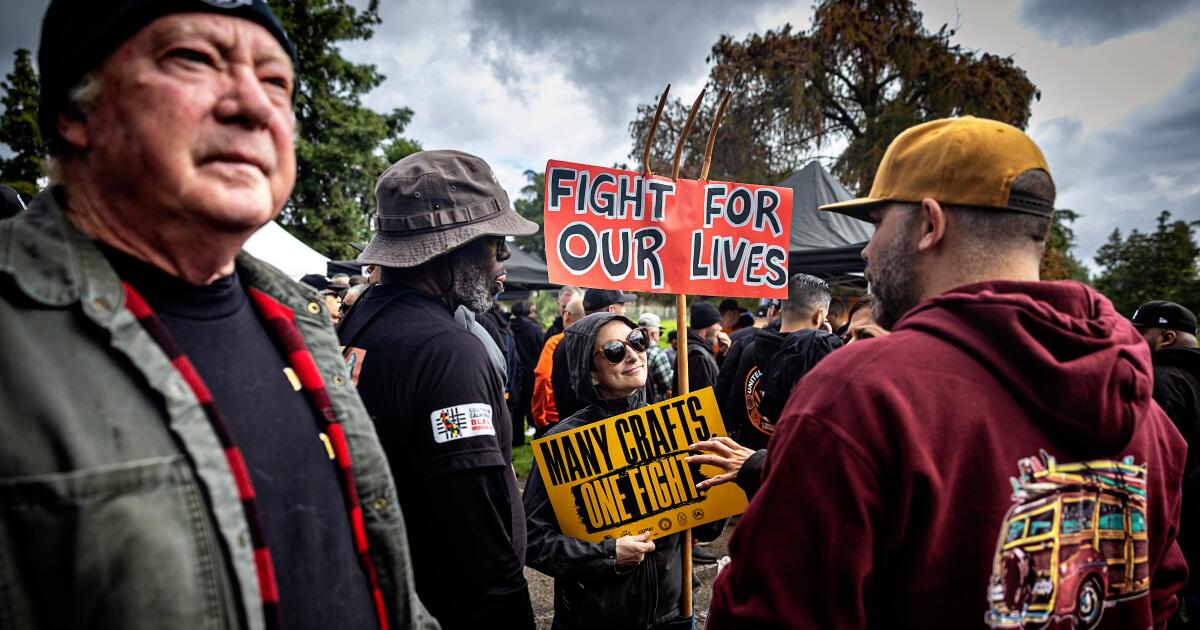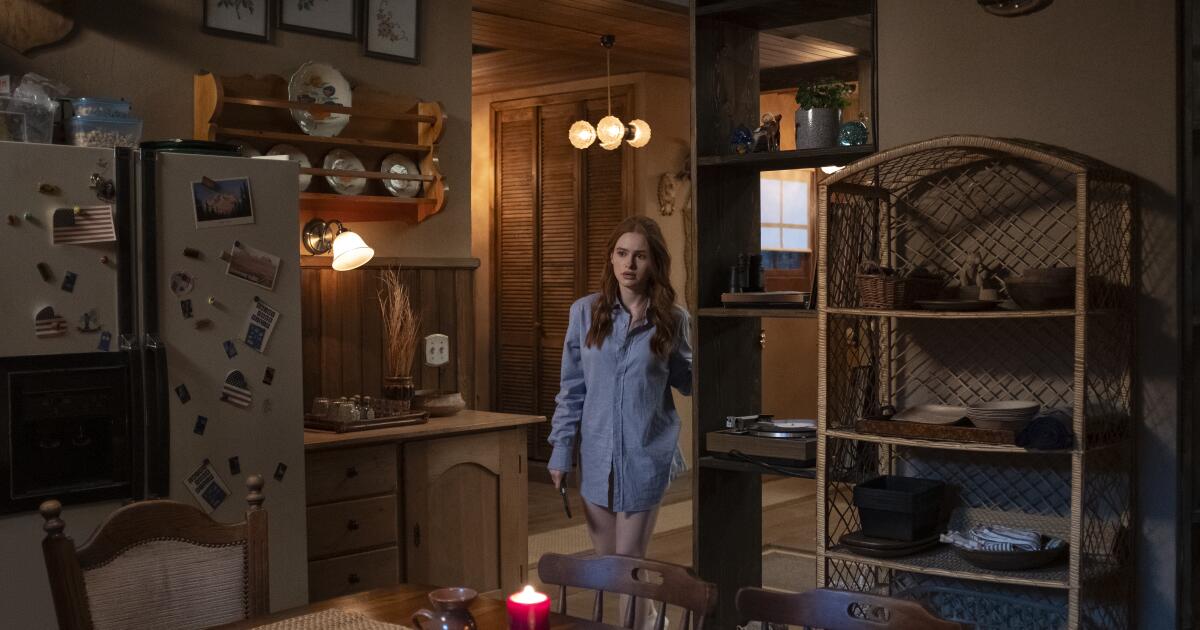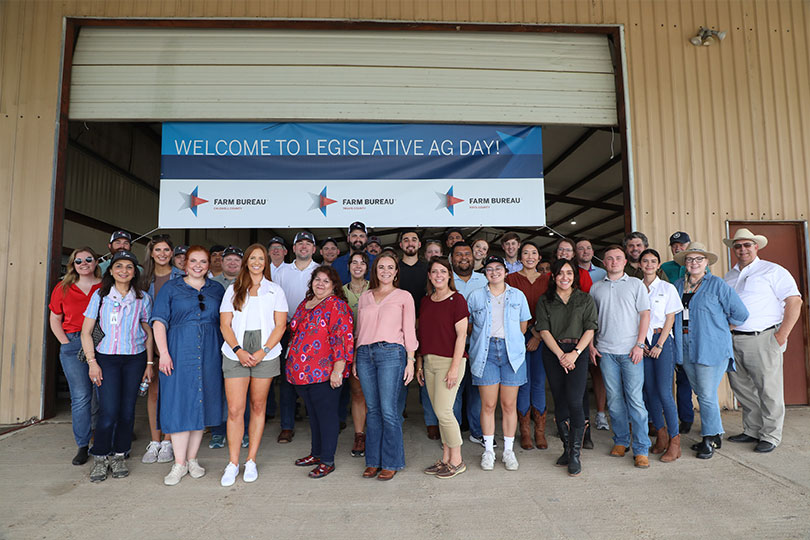Entertainment
Hollywood's crew union negotiations have gone well so far. Now the hard part begins

In a departure from the labor rebellions that roiled Hollywood last year, the latest set of contract negotiations between a major entertainment union and the top studios has unfolded about as smoothly as could be expected. So far.
The various West Coast studio locals that make up the International Alliance of Theatrical Stage Employees, which advocates for film and TV crew members, have engaged over the past month in separate bargaining sessions with the Alliance of Motion Picture and Television Producers, which represents Disney, Netflix, Warner Bros and other entertainment companies.
Those talks — tailored to the specific concerns of costume designers, hair and makeup artists, set decorators and other workers — transpired without incident.
Now the union representing so-called below-the-line workers is poised to enter broader negotiations on Monday for its basic agreement, which will cover the most pressing items affecting entertainment craftspeople. This phase is the big one that could, depending on how talks go, result in another historic agreement or yet another work stoppage.
“The stakes are very high … certainly in light of what happened last year,” said Todd Holmes, associate professor of cinema and television arts at Cal State Northridge.
“It’s a challenging environment,” he added. “There’s need for cautious optimism because of what’s gone on individually with the crafts, but I still think it’s going to take some time to iron out an agreement.”
Unlike the Screen Actors Guild-American Federation of Television and Radio Artists and the Writers Guild of America, IATSE has never staged a nationwide strike in its 131-year history. It came close, however, in 2021 when crew members overwhelmingly voted in favor of authorizing a walkout. (IATSE and the AMPTP ultimately averted a work stoppage by settling their standoff shortly before the strike was set to commence.)
This year, a crew member walkout is looking decreasingly likely. However, some have speculated that the slow return to production in the wake of the writers’ and actors’ labor actions could be due in part to the companies playing it extra safe in anticipation of another potential shutdown.
The overlapping writers’ and actors’ walkouts came as a devastating blow on both sides of the bargaining table, rendering countless crew members jobless for at least six months and upending the release schedules of the entertainment companies, which were already struggling financially due to overspending from the streaming wars.
“Look, people need to work,” said Matthew Loeb, IATSE’s international president. “And to the extent that our goals are met, the earlier [a deal is struck] the better. … We don’t want companies holding off on greenlighting pictures or moving them. We want to keep the business on track and make the recovery from last year.”
In a statement provided to The Times, a spokesperson for the studios said, “The AMPTP is pleased by the progress we have made and remains focused on the task at hand: collaborating with our union partners to reach a fair deal that keeps crew members on the job without interruption and recognizes the contributions they make to our industry.”
Prior to the start of general negotiations, the 13 Hollywood locals struck tentative deals with the AMPTP according to each group’s needs.
The trade-specific agreements fell like dominoes, beginning March 22 with the cinematographers (Local 600), art directors (Local 800) and set painters (Local 729) and ending last week with the studio teachers (Local 884) and affiliated property craftspeople (Local 44). The union has remained tight-lipped about the contents of those deals, though craft-specific contracts historically have addressed issues such as workflow for editors, camera operating practices and working conditions for costumers.
Loeb hopes that’s a good omen for the tenor of the ongoing negotiations.
“It’s civil,” Loeb said. “I think their demeanor is right. Everybody wants to avoid a strike. But that’s not to say that it’s a foregone conclusion that they’ll meet our demands.
“It’s not a war,” he added. “We don’t bargain for a strike. We bargain for a contract.”
This wave of bargaining is expected to cover topics such as wages, pension and health benefits, work-life balance and job security, as well as streaming residuals and artificial intelligence, which emerged as sticking points during the writers’ and actors’ contract campaigns.
The efficiency of the craft-specific talks bodes well for the general negotiations, Holmes observed. He noted, however, that the parties’ “reconciliatory tone” could “go south or … change quickly” over hot-button issues such as AI.
Terms related to pay, subcontracting, work-life balance and AI could prove especially challenging to nail down in general negotiations — which will introduce “more difficult issues,” according to a source close to the studios who was not authorized to comment.
In a Monday memo to IATSE members, business representatives for the 13 locals described the general stage as “the bigger challenge ahead,” citing “more complex and consequential” agenda items.
IATSE is seeking “significant” wage increases to keep up with inflation, higher penalties for rest-period violations, enhanced sick leave and bumps in streaming residuals, as well as regulations around subcontracting and AI. Crew members also are demanding additional funding for their pension and health plans amounting to at least $670 million.
The union has said it doesn’t intend to prolong regular talks beyond the current contract’s expiration date of July 31.
By then, “My hope is that we will have an agreement to send out for ratification,” Loeb said. “But if we don’t, then … it would be a strike authorization vote.”
The first round of general negotiations is tentatively scheduled to run from April 29 through May 16. Loeb said that the best-case scenario would deliver a resolution in less than two months.
“Conversations have been productive to date, but it’s going to take a while to work through the issues on the table in general negotiations as they’re very complicated” and can’t be resolved overnight, said a source close to the studios who was not authorized to comment.
In March, IATSE, Teamsters Local 399 and other unions representing more than 66,000 below-the-line workers hosted a rally in Encino’s Woodley Park to kick off their simultaneous contract campaigns. The event was attended by thousands of industry professionals, including crew members, writers and actors — fresh off the success of their own labor actions.
“The AMPTP, they learned a lesson,” Holmes said. “The WGA and SAG played hardball with them, and they held out longer than [the studios] anticipated. So I think that the AMPTP is in more of a mode of negotiation … than they were a year ago.”

Movie Reviews
‘Bird’ Review: Andrea Arnold Switches Up Her Playbook With a Warmhearted Fable Starring Barry Keoghan and Franz Rogowski

British auteur Andrea Arnold follows up her last feature, the poignant, non-verbal slice-of-farmyard-life that is the documentary Cow, with a new member of her cinematic menagerie: drama Bird, an uplifting competitor for Cannes’ Palme d’Or.
With mostly human characters and actual dialogue, in some ways this is taxonomically more like her gritty-as-asphalt, early social-realist work, especially Fish Tank and Oscar-winning short Wasp, which, like Bird, were shot in the southerly county of Kent, U.K., where Arnold grew up. But then suddenly, out of the milieu’s marshy semi-urban landscape of empty beer cans, cigarette butts, domestic abuse and despair, the film takes magical-realist flight and transforms into something unlike anything Arnold’s done before. Thanks to the director’s magisterial knack with actors (especially non-professionals such as terrific adolescent discovery Nykiya Adams, who, as the protagonist, is in nearly every frame of the film), the result is quite entrancing.
Bird
The Bottom Line Flies high.
Venue: Cannes Film Festival (Competition)
Cast: Nykiya Adams, Jason Edward Buda, James Nelson Joyce, Barry Keoghan, Jasmine Jobson, Frankie Box, Franz Rogowski
Director/screenwriter: Andrea Arnold
1 hour 59 minutes
That said, at times this teeters on the brink of sentimentality, as if all that time Arnold has spent in the U.S. directing episodes of upscale television (Big Little Lies, Transparent, I Love Dick) has rubbed off and added a kind of American-indie-style slickness to the script — a tidy, over-workshopped tightness that the raw early films and American Honey mostly eschewed. But that may be exactly what some viewers will love about Bird. Given the presence of stars like Barry Keoghan and Franz Rogowski (both of them amping up the Barry Keoghan and Franz Rogowski-ness of it all to the max), this could be Arnold’s most commercial feature film.
Like nearly all of Arnold’s previous films, even Cow at a stretch, Bird takes pains to show all the beauty and the bloodshed, to borrow a phrase from Nan Goldin’s life, of working-class life. That means copping to the fact there is violence, addictive behavior and outright neglect within families, the sort of stuff middle-class folks primly call “bad parenting.” At the same time, “neglect” can also produce self-reliance and independence in children, who in this film are often seen running around the streets by themselves, playing unsupervised, older ones looking after younger ones, inventing their own games like “jump on the disused mattress in the front yard” and so on. All of it is exactly the sort of stuff kids got up to in the proverbial old days, the golden-hued mythical past that was also supposedly so much better than things are now.
Twelve-year-old Bailey (Adams) certainly has a remarkable amount of freedom, maybe a little too much. She lives in a large, squatted building in Gravesend, a ramshackle property — festooned with graffiti and furnished with furniture that looks like it was salvaged from a dumpster — that houses quite a few people in apartments on each floor, many of them animal lovers like Bailey and her family. On the floor Bailey lives on, she shares a space with her dad Bug (Keoghan, having an absolute blast), an unemployed party animal whose latest get-rich-quick scheme is to harvest the hallucinogenic slime off an imported toad, called “the drug toad” throughout. Bailey’s slightly older half-brother Hunter (Jason Edward Buda), who was born when Bug himself was only 14, also lives there, although he spends a lot of time with his “gang” (really just a bunch of kids) and his girlfriend, Moon.
As the film opens, Bailey learns that Bug plans on marrying Kayleigh (Frankie Box), his latest squeeze whom he’s only been dating for three months. The wedding is set for this coming Saturday, and when Bailey refuses to wear or even try on the sequined, pink, leopard-skin patterned catsuit Kayleigh has picked out for her and her own daughter to wear as bridesmaids, there’s a noisy row between Bailey and Bug that gets a little physical.
Later on, we meet Bailey’s mother Peyton (Jasmine Jobson), who lives in another house across town that seems perpetually full of high 20somethings in the living room. Upstairs in Peyton’s bed, there’s a monstrous new boyfriend named Skate (James Nelson Joyce). Peyton’s kids, Bailey’s three younger siblings (it’s not clear who their dad is), fend for themselves as best they can. Subtly dropped hints in the dialogue suggest Bailey went to live with Bug at a young age, and feels unwanted by her mother. Guilt, anger, recrimination and hurtful words drift all around this family, like poplar tree fluff in June.
It’s a crowded extended community where everyone kind of knows each other and Hunter and his buddies dish out vigilante violence to people rumored to have hurt kids or their friends. But one day, a stranger arrives among them: Bird (Rogowski). Dressed in a swingy skirt and a complexly cabled thrift-shop sweater, the German-accented Bird has a fey, otherworldly quality about him. Like the seagulls and ravens that Bailey is drawn to and often films on her cellphone (clearly she’s a budding filmmaker), Bird is enigmatic, itinerant, restless and fundamentally other. After doing a charming, flappy dance around a field for Bailey’s camera, he flounces off to town to look for his parents in a tower block. Gradually, he and Bailey become friends — or as much as two wild creatures of different species can be friends.
Arnold starts dropping little hints early on that some supernatural or fantastical force is at work here, and it would spoil the movie to reveal too much. It all gets quite plot-heavy for an Arnold film. For example, nothing much at all happens in American Honey for massive stretches, which was charming and tedious in equal measures. This one has last-minute dashes to stop people leaving on trains, a melodramatic backstory reveal, and even visual-effects-generated surprises involving visits from yet more members of the animal kingdom. (Spoiler: It’s an adorable fox!) Indeed, throughout, there are shots of bees, butterflies, crows and all manner of urban beasties, underscoring the fecundity of the Kentish landscape: a compellingly primal mix of wild estuarine marshes with factories, beaches fringed with lurid amusement arcades and unattractive attractions, a sense of faded, sticky and sand-flecked splendor gone to seed.
And yet, despite the palpable darkness in the corners of the story and the pervasive sense of melancholy, the film ends on a gloriously optimistic, cotton-candy-scented note of joy. Nearly the whole ensemble enjoys a line dance to “Cotton Eye Joe,” a needle drop almost as good as the opening electric-scooter ride sequence set to Fontaines DC’s punky, atonal song “Too Real.” As per usual, Arnold picks a killer soundtrack, and she loves to get her cast dancing.
Keoghan, of course, obliges, offering a little throwback to his end-reel naked romp in Saltburn. (A character can be heard at one point dissing that viral moment’s backing track, “Murder on the Dance Floor,” only for another character to confess he loves that song.) Rogowski, who threw a mean shape or two in such films as Disco Boy and Passages, also contributes a very physical performance, cavorting around Gravesend like a shy woodland faun or fowl. It’s enough to send an audience out feeling giddy and a smidge weepy in the best sort of way.
Entertainment
Review: 'The Strangers – Chapter 1' is a rote rehash that lacks the original film's creepy suspense

“The Strangers – Chapter 1” is the third film in an ongoing franchise, following the surprise hit of 2008’s “The Strangers” and its diminishing-returns 2018 sequel, “The Strangers: Prey at Night.” The new film is also the first of three movies shot concurrently and intended to be released within the next year.
Director Renny Harlin, new to the series, is no stranger to sequels, with a long resume that includes “Die Hard 2” and “A Nightmare on Elm Street 4: The Dream Master.” There is a journeyman’s proficiency to “Chapter 1” but little in the way of real spark.
Young couple Maya (Madelaine Petsch, also an executive producer) and Ryan (Froy Gutierrez) are on a road trip across the country so Maya can interview for a job at an architecture firm in Portland. After a bit of car trouble, they find themselves unexpectedly staying the night at a remote Airbnb in a small Oregon town. A stranger knocks on their door asking for someone who isn’t there and they soon find themselves besieged by a man and two women, all wearing eccentric masks.
The wittiest moment comes just a few minutes in when a title card declares how many violent crimes have occurred in America since the film began. There is little else in the movie that signals that kind of self-awareness aside from scattered acknowledgment of elements lifted from the first film, such as a specific song by Joanna Newsom on a record player. The most visually inventive idea in the entire movie is the placement of the camera inside a refrigerator as Gutierrez sets a six-pack of beer down and his face remains perfectly framed by the bottles.
“The Strangers – Chapter 1” never conjures the original’s feelings of rustic menace.
(John Armour / Lionsgate)
Before the masked invaders have fully launched their attack, Maya and Ryan enjoy a post-coital cuddle on the sofa of their sketchy rental place, with Maya wearing only a shirt that skims the top of her thighs. Ryan goes into town under some pretense or another — there is much needless business in the film about a missing inhaler — leaving Maya by herself. As the Strangers methodically begin their sordid work, Maya hangs out, smokes pot, checks the door and noodles on a piano. Rather than wanting to scream for her to look out for what’s behind her, audiences may want to shout for her to just put on some pants.
The first “Strangers” movie had an air of creepy suspense, as the besieged couple often looked off into blank space, bringing an unnerving tension to what was often nothing. The new film never conjures the same feelings of rustic menace.
“The Strangers – Chapter 1” ends with a — spoiler alert! — title card that reads “To Be Continued.” (Plus a brief mid-credits stinger scene.) Building out the mythology of the attackers or making this anything other than a brief, inexplicable and random encounter, as the subsequent films apparently promise to do, diminishes the core terror of the essential premise of the first film, that sometimes bad things just happen.
There is a strange courage to assuming that your horror sequel will demand/deserve two more outings. Wanting audiences to sit through a warmed-over rehash of a preexisting film to get to even the possibility of something new in the story of the upcoming installments feels like a big ask.
The original “Strangers” made the walk to the parking lot after feel weird, or inspired some securing of doors and windows at home. Not so with the rote stylings of the new film. The knock at the door of “The Strangers – Chapter 1” can simply go unanswered.
‘The Strangers: Chapter 1’
Rating: R for horror violence, language and brief drug use
Running time: 1 hour, 31 minutes
Playing: In wide release Friday, May 17
Movie Reviews
Guruvayoor Ambalanadayil movie review: This Prithviraj Sukumaran, Basil Joseph-starrer is a total laugh riot

When there is a wedding, there are obviously several families involved, a tense bride and groom, friends who provide emotional support, and relatives and others trying to resolve the numerous issues that crop up as the wedding nears. Director Vipin Das’ Guruvayoor Ambalanadayil involves all that along with copious amounts of humour added to the proceedings. Also read | Aadujeevitham The Goat Life movie review: Prithviraj Sukumaran delivers extraordinary performance in Blessy directorial
The director’s previous film Jaya Jaya Jaya Jaya Hey also centred on marriage and was a black comedy but this one is a comedy drama that’s centred around Vinu Ramachandran’s (Basil Joseph) wedding.
The premise
Vinu works in Dubai and after suffering from a heart break-up for five years, he finally decides to get hitched. It is all thanks to his future brother-in-law Anandan, (Prithviraj Sukumaran) who constantly advises him to forget his ex-girlfriend Parvathy and marry his sister Anjali (Anaswara Rajan), that Vinu agrees to get hitched. As Vinu grows closer to Anjali, he develops a very strong bond with Anandan whom he considers an elder brother and confidante.
He soon learns that Anandan has had some issue in his marriage and as a return favour, convinces him to get back with his wife so they can all be one big happy family. However, fate seems to have others plans for both Vinu and Anandan and Vinu’s past life and wrongdoings come back to haunt him right before marriage. A shocking revelation throws their friendship and Vinu’s marriage in jeopardy and everything he touches turns to disaster. What is this revelation? And does Vinu finally get married to Anjali?
Guruvayoor Ambalanadayil is a Vipin Das-directorial that has been written by Deepu Pradeep. Both the director and writer seem to be in complete sync as the comic caper they have delivered is a laugh riot, despite some of the cliches. Pradeep has written a wedding drama that has humour interwoven beautifully into the situations that arise at every turn. He establishes the comic factor right from the get go and as the film progresses you see various characters being slowly introduced to take the story forward. So if you have Yogi Babu at one point, then you have his office colleague at another.
The performances
While one may say there are too many characters at one point, it luckily doesn’t spoil the narrative of this wholesome family entertainer. As for Vipin Das, he has on board a talented cast who have made this film all the more festive thanks to their strong performances.
Prithviraj Sukumar, who is a co-producer on this project, comes off the back of his serious survival drama Aadujeevitham (The Goat Life) into this comedy drama. The role of Anandan requires perfect comic timing and expressions to suit the funny situations, and the talented Malayalam star has shown that he can deliver in such a role too. Prithviraj has tried to break out of stereotypes time and again and this film shows that he can not just essay roles with emotional depth but light-hearted ones as well. In fact, he seems to have thoroughly enjoyed playing Anandan in this film.
Final thoughts
In Guruvayoor Ambalanadayil, Das has once again teamed up with Basil Joseph with whom he worked in his 2022 blockbuster, Jaya Jaya Jaya Jaya Hey. Basil is known for his restrained performances where the humour comes off his expressions and dialogue delivery. And he is a delight as Vinu, someone who lacks confidence and believes he’s a lion though he’s just a cat. Nikhila Vimal and Anaswara Rajan have smaller but impactful roles while the rest of the large cast deliver what is required.
Music director Ankit Menon, who has worked with Vipin Das earlier, has scored the music for this film. He has combined some new age beats along with traditional music, like the wedding song. If we saw Ilaiyaraaja’s Tamil song from Guna (1991) being the highlight of the recent Manjummel Boys, in this film it is the Tamil song Azhagiya Laila from director Sundar C’s Ullathai Allitha (1996) that is the highlight.
Guruvayoor Ambalanadayil is a complete laugh riot, coupled with splendid performances, that families will thoroughly enjoy. Prithviraj Sukumaran has another winner on his hands.
-

 News1 week ago
News1 week agoMan, 75, confesses to killing wife in hospital because he couldn’t afford her care, court documents say
-

 World1 week ago
World1 week agoPentagon chief confirms US pause on weapons shipment to Israel
-

 Politics1 week ago
Politics1 week agoRFK Jr said a worm ate part of his brain and died in his head
-

 Politics1 week ago
Politics1 week ago'You need to stop': Gov. Noem lashes out during heated interview over book anecdote about killing dog
-

 Politics1 week ago
Politics1 week agoBiden takes role as bystander on border and campus protests, surrenders the bully pulpit
-

 World1 week ago
World1 week agoConvicted MEP's expense claims must be published: EU court
-

 Politics1 week ago
Politics1 week agoHere's what GOP rebels want from Johnson amid threats to oust him from speakership
-

 World1 week ago
World1 week agoPro-Palestine protests: How some universities reached deals with students















